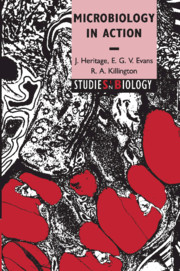Book contents
- Frontmatter
- Contents
- Preface
- 1 The microbiology of soil and of nutrient cycling
- 2 Plant–microbe interactions
- 3 The microbiology of drinking water
- 4 Microbial products
- 5 Food microbiology
- 6 The human commensal flora
- 7 Microbial infections
- 8 Chemotherapy and antibiotic resistance
- Further reading
- Glossary
- Index
1 - The microbiology of soil and of nutrient cycling
Published online by Cambridge University Press: 05 June 2012
- Frontmatter
- Contents
- Preface
- 1 The microbiology of soil and of nutrient cycling
- 2 Plant–microbe interactions
- 3 The microbiology of drinking water
- 4 Microbial products
- 5 Food microbiology
- 6 The human commensal flora
- 7 Microbial infections
- 8 Chemotherapy and antibiotic resistance
- Further reading
- Glossary
- Index
Summary
Soil is a dynamic habitat for an enormous variety of life-forms. It gives a mechanical support to plants from which they extract nutrients. It shelters many animal types, from invertebrates such as worms and insects up to mammals like rabbits, moles, foxes and badgers. It also provides habitats colonised by a staggering variety of microorganisms. All these forms of life interact with one another and with the soil to create continually changing conditions. This allows an on-going evolution of soil habitats.
The activity of living organisms in soil helps to control its quality, depth, structure and properties. The climate, slope, locale and bedrock also contribute to the nature of soil in different locations. The interactions between these multiple factors are responsible for the variation of soil types. Consequently, the same fundamental soil structure in different locations may be found to support very different biological communities. These complex communities contribute significantly to the continuous cycling of nutrients across the globe.
What habitats are provided by soil?
Soil forms by the breakdown of bedrock material. Erosion of rocks may be the result of chemical, physical or biological activity, or combinations of the three factors. Dissolved carbon dioxide and other gases cause rain water to become slightly to moderately acid. This pH effect may cause the breakdown of rocks such as limestone. Physical or mechanical erosion can result from the action of wind or water, including ice erosion.
- Type
- Chapter
- Information
- Microbiology in Action , pp. 1 - 15Publisher: Cambridge University PressPrint publication year: 1999
- 1
- Cited by

